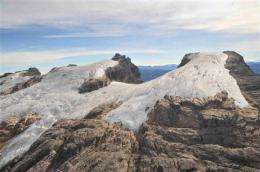Indonesia's last glacier will melt within years

(AP) -- Lonnie Thompson spent years preparing for his expedition to the remote, mist-shrouded mountains of eastern Indonesia, hoping to chronicle the affect of global warming on the last remaining glacier in the Pacific. He's worried he got there too late.
Even as he pitched his tent on top of Puncak Jaya, the ice was melting beneath him.
The 3-mile- (4,884-meter-) high glacier was pounded by rain every afternoon during the team's 13-day trip, something the American scientist has never encountered in three decades of drilling ice cores. He lay awake at night listening to the water gushing beneath him.
By the time they were ready to head home, ice around their sheltered campsite had melted a staggering 12 inches (30 centimeters).
"These glaciers are dying," said Thompson, one of the world's most accomplished glaciologists. "Before I was thinking they had a few decades, but now I'd say we're looking at years."
Thompson has led 57 such expeditions in 16 countries around the planet, from China to Peru.
But for him, the Papuan glaciers, because they lie along the fringe of the world's warmest ocean and could provide clues about regional weather patterns, were an unexplored "missing link."
It is this region that generates El Nino disturbances and influences climate from India's monsoons to the Amazon's droughts.
As such, it is one of the only "archives" about the story of the equatorial phenomenon, said Michael Prentice of the Indiana Geological Survey, who has long been interested in the area. It also could point to what lies ahead for billions of people in Asia.
The ice that covered much of Papua thousands of years ago is today just 1 square mile (2 square kilometers) wide and 32 yards (meters) deep. Deep crevasses crisscross the dirty ice.
Glaciers worldwide are in retreat, with major losses already seen across much of Alaska, the Alps, the Andes and numerous other ranges. What makes Puncak Jaya different, aside from its location in the Pacific, is just how little is known about it.
Research permits to work in Papua are difficult to obtain, in part because Indonesia's government is hugely sensitive to the region's long-simmering insurgency. Foreign journalists are barred and humanitarian groups are restricted.
It is also one of the most isolated corners of the sprawling archipelagic nation.
The U.S. mining company Freeport-McMoRan, operating nearby, helped airlift the team to Puncak Jaya's heights by helicopter, along with four tons of equipment - from electromechanical and thermal drill systems, to radars needed to map the underlying rock, said one of its employees, Scott Hanna.
There was a winch and cables, high-altitude camping gear and boxes to preserve ice samples, which will eventually join 70,000 yards (meters) of tropical cores being kept in cold storage in Columbus, Ohio.
There, glaciologists will help analyze the ice layer by layer through centuries past.
Flecks of dust, falling seasonally, enable them to count down the years, much like tree rings. Isotopes of oxygen, in minute air bubbles trapped in the ice, vary with temperature helping researchers understand how ancient weather shifted.
"I just hope we weren't too late," said Thompson, 62, adding that in addition to melting from the top, water likely seeped in to the base of the glacier, leaving them with limited records from a section of time.
Discover the latest in science, tech, and space with over 100,000 subscribers who rely on Phys.org for daily insights. Sign up for our free newsletter and get updates on breakthroughs, innovations, and research that matter—daily or weekly.
"But still, the have horizontal layers all the way through, so I think we were able to salvage at least a little bit of the climate history," said Thompson of Ohio State University, who co-coordinated the expedition with Dwi Susanto of Columbia University.
Among other things, the team expects to find volcanic ash from past eruptions - the 1883 blast of Krakatau and Tambora in 1815 should help serve as timelines - soot from wildfires, pollen, plant debris and maybe even frozen animals.
Satellite images and aerial photos have long shown the glacier in rapid retreat.
The mountain has lost about 80 percent of its ice since 1936 - two-thirds of that since the last scientific expedition in the early 1970s.
Thompson says he thinks temperatures are rising twice as fast in high altitudes as at the earth's surface, which, if true, could have broad implications on people who depend on glaciers for water during the dry season, such as in the Himalayas.
Geoffrey Hope, a professor at Australian National University who took part in the 1971 expedition to Puncak Jaya, noted that Papua has the wettest mountain region in the world, so high precipitation levels didn't come as a great surprise.
Still, his own experience was markedly different.
"The roof of our marque tent fell in on many evenings due to the weight of the snow," he recalled, "and all water coming from the glacier would freeze by 8 p.m. each night."
More information:
http://blogs.ei.columbia.edu/blog/tag/indonesia-puncak-jaya/
http://www.earth.columbia.edu/videos/watch/247
©2010 The Associated Press. All rights reserved. This material may not be published, broadcast, rewritten or redistributed.

















